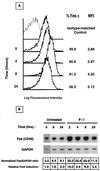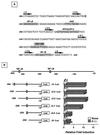Activation-dependent transcriptional regulation of the human Fas promoter requires NF-kappaB p50-p65 recruitment
- PMID: 10022897
- PMCID: PMC84003
- DOI: 10.1128/MCB.19.3.2098
Activation-dependent transcriptional regulation of the human Fas promoter requires NF-kappaB p50-p65 recruitment
Abstract
Fas (CD95) and Fas ligand (CD95L) are an interacting receptor-ligand pair required for immune homeostasis. Lymphocyte activation results in the upregulation of Fas expression and the acquisition of sensitivity to FasL-mediated apoptosis. Although Fas upregulation is central to the preservation of immunologic tolerance, little is known about the molecular machinery underlying this process. To investigate the events involved in activation-induced Fas upregulation, we have examined mRNA accumulation, fas promoter activity, and protein expression in the Jurkat T-cell line treated with phorbol myristate acetate and ionomycin (P/I), pharmacological mimics of T-cell receptor activation. Although resting Jurkat cells express Fas, Fas mRNA was induced approximately 10-fold in 2 h upon P/I stimulation. Using sequential deletion mutants of the human fas promoter in transient transfection assays, we identified a 47-bp sequence (positions -306 to -260 relative to the ATG) required for activation-driven fas upregulation. Sequence analysis revealed the presence of a previously unrecognized composite binding site for both the Sp1 and NF-kappaB transcription factors at positions -295 to -286. Electrophoretic mobility shift assay (EMSA) and supershift analyses of this region documented constitutive binding of Sp1 in unactivated nuclear extracts and inducible binding of p50-p65 NF-kappaB heterodimers after P/I activation. Sp1 and NF-kappaB transcription factor binding was shown to be mutually exclusive by EMSA displacement studies with purified recombinant Sp1 and recombinant p50. The functional contribution of the kappaB-Sp1 composite site in P/I-inducible fas promoter activation was verified by using kappaB-Sp1 concatamers (-295 to -286) in a thymidine kinase promoter-driven reporter construct and native promoter constructs in Jurkat cells overexpressing IkappaB-alpha. Site-directed mutagenesis of the critical guanine nucleotides in the kappaB-Sp1 element documented the essential role of this site in activation-dependent fas promoter induction.
Figures






Similar articles
-
An Sp1 binding site involves the transcription of the Fas ligand gene induced by PMA and ionomycin in Jurkat cells.J Biomed Sci. 2000 Mar-Apr;7(2):136-43. doi: 10.1007/BF02256620. J Biomed Sci. 2000. PMID: 10754388
-
A regulatory element in the CD95 (APO-1/Fas) ligand promoter is essential for responsiveness to TCR-mediated activation.Eur J Immunol. 1998 Aug;28(8):2373-83. doi: 10.1002/(SICI)1521-4141(199808)28:08<2373::AID-IMMU2373>3.0.CO;2-T. Eur J Immunol. 1998. PMID: 9710215
-
Transcriptional regulation of the human GD3 synthase gene expression in Fas-induced Jurkat T cells: a critical role of transcription factor NF-kappaB in regulated expression.Glycobiology. 2006 May;16(5):375-89. doi: 10.1093/glycob/cwj087. Epub 2006 Feb 15. Glycobiology. 2006. PMID: 16481330
-
NF-kappa B RelA (p65) is essential for TNF-alpha-induced fas expression but dispensable for both TCR-induced expression and activation-induced cell death.J Immunol. 2001 Apr 15;166(8):4949-57. doi: 10.4049/jimmunol.166.8.4949. J Immunol. 2001. PMID: 11290773
-
NF-kappaB regulates Fas/APO-1/CD95- and TCR- mediated apoptosis of T lymphocytes.Eur J Immunol. 1999 Mar;29(3):878-86. doi: 10.1002/(SICI)1521-4141(199903)29:03<878::AID-IMMU878>3.0.CO;2-9. Eur J Immunol. 1999. PMID: 10092091
Cited by
-
A novel AP-1 element in the CD95 ligand promoter is required for induction of apoptosis in hepatocellular carcinoma cells upon treatment with anticancer drugs.Mol Cell Biol. 2000 Oct;20(20):7826-37. doi: 10.1128/MCB.20.20.7826-7837.2000. Mol Cell Biol. 2000. PMID: 11003676 Free PMC article.
-
High cell surface death receptor expression determines type I versus type II signaling.J Biol Chem. 2011 Oct 14;286(41):35823-35833. doi: 10.1074/jbc.M111.240432. Epub 2011 Aug 24. J Biol Chem. 2011. PMID: 21865165 Free PMC article.
-
Arsenite sensitizes human melanomas to apoptosis via tumor necrosis factor alpha-mediated pathway.J Biol Chem. 2004 May 21;279(21):22747-58. doi: 10.1074/jbc.M314131200. Epub 2004 Mar 17. J Biol Chem. 2004. PMID: 15028728 Free PMC article.
-
Different class IIa HDACs repressive complexes regulate specific epigenetic responses related to cell survival in leiomyosarcoma cells.Nucleic Acids Res. 2020 Jan 24;48(2):646-664. doi: 10.1093/nar/gkz1120. Nucleic Acids Res. 2020. PMID: 31754707 Free PMC article.
-
A single-cell map of dynamic chromatin landscapes of immune cells in renal cell carcinoma.Nat Cancer. 2022 Jul;3(7):885-898. doi: 10.1038/s43018-022-00391-0. Epub 2022 Jun 6. Nat Cancer. 2022. PMID: 35668194 Free PMC article.
References
-
- Aries S, Scgaaf B, Muller C, Dennin R, Dalhoff K. Fas (CD95) expression of CD4+ T cells from HIV-infected patients increases with disease progression. J Mol Med. 1995;73:591–593. - PubMed
-
- Azizkhan J C, Jensen D E, Pierce A J, Wade M. Transcription from TATA-less promoters: dihydrofolate reductase as a model. Crit Rev Eukaryot Gene Expr. 1993;3:229–254. - PubMed
-
- Behrmann I, Walczak H, Krammer P H. Structure of the human APO-1 gene. Eur J Immunol. 1994;24:3057–3062. - PubMed
Publication types
MeSH terms
Substances
Grants and funding
LinkOut - more resources
Full Text Sources
Research Materials
Miscellaneous
